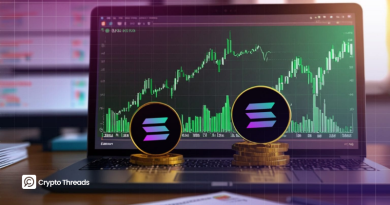Ethereum $60K Vision: Tom Lee and the BitMine Treasury Play
Key Takeaways:
- Ethereum Timing Opportunity: Current institutional adoption places Ethereum at a stage similar to Bitcoin in 2017. Its under-ownership signals major upside as Wall Street begins allocating.
- Treasury Premium Justified: Active management that grows ETH per share deserves a premium over static ETFs. Staking yields further strengthen the case.
- Execution Excellence Matters: BitMine’s rapid rise highlights the power of a clean balance sheet, sharp execution, and disciplined capital use — a standard many treasuries will fail to meet.
- Long-term Thesis Intact: Despite volatility, structural forces like tokenization, institutional entry, and regulatory progress underpin a durable Ethereum bull case.
- Risk Management Critical: Companies with transparent, debt-free structures are better equipped to survive crypto winters, avoiding the traps that complex financing can create.
When a Wall Street Analyst Bets on the Future
In August 2020, Michael Saylor shocked Wall Street by turning MicroStrategy into a Bitcoin treasury company. That bold move opened a new chapter in corporate finance. But today’s story is not about Bitcoin, it’s about Ethereum, and a new experiment playing out in real time.
At the center is Tom Lee, former JP Morgan strategist and now Chairman of BitMine, the world’s largest Ethereum treasury company. In a recent Medici Level Up podcast, Lee drew a striking historical parallel: Ethereum in 2025, he said, looks like 1971, the year the U.S. dollar severed its link to gold.
“Wall Street moving onto crypto rails is Ethereum’s 1971 moment,” Lee declared with trademark conviction. And the numbers back him up. In just two months since launch, BitMine’s value per share has surged from 4 ETH to more than 40 ETH, a ten-fold leap that even veteran bull-market investors find staggering.
This article dives into Tom Lee’s bold vision, BitMine’s breakneck rise, and the new wave of Ethereum treasuries that are quietly rewriting Wall Street’s playbook, from regulatory shake-ups and tokenization bets to the showdown between ETFs and treasury strategies, and Lee’s conviction that Ethereum’s path could stretch all the way to $60,000.
Tome Lee – From Skeptic to Crypto Pioneer
Who is Tom Lee?
Born and raised in Michigan, Thomas Jong Lee, known as Tom Lee, has spent three decades shaping Wall Street’s view of markets. A Wharton graduate in finance and accounting, he began his career at Kidder Peabody and Salomon Smith Barney before becoming Chief Equity Strategist at JPMorgan from 2007 to 2014. During that period, Institutional Investor consistently ranked him among the industry’s top strategists.

In 2014, Lee left the banking world and launched Fundstrat Global Advisors, a research firm built to deliver insights once reserved for hedge funds to a wider audience. His bold calls, including the prediction of a V-shaped recovery during the 2020 market crash, earned him mainstream recognition and a Wall Street Journal cover story.
Lee’s journey to crypto began in 2017 when Bitcoin broke above $1,000. At JPMorgan, most dismissed it as a tool for criminals. Lee saw something else: a network that had grown from nothing to a $10 billion market cap in under a decade. With the Fundstrat team, he built a model using wallet growth and transaction activity, which explained more than 90% of Bitcoin’s price movement from 2010 to 2017. That framework produced a controversial forecast, $25,000 Bitcoin by 2022. The market eventually proved him right.
By 2025, his focus shifted to Ethereum. As Chairman of BitMine Immersion Technologies, Lee oversaw its transformation from a miner into one of the largest Ethereum treasuries in existence, with holdings surpassing 1.8 million ETH. He now argues that Ethereum is at its own “1971 moment,” a turning point as decisive as when the U.S. dollar severed its link to gold.
Regularly featured on CNBC’s Fast Money, Tech Check, and Halftime Report, Lee has become one of the most influential voices bridging traditional finance and crypto. His message is clear: Ethereum is not just another token, but the backbone of the next era of financial infrastructure.
Ethereum Pivot (2025)
By 2025, Tom Lee no longer viewed Ethereum as a side bet. The political mood in Washington was shifting, Wall Street was leaning in, and the timing was too clear to ignore. Ethereum had moved from background noise to the main stage.
The first spark came from the stablecoin boom. Circle’s IPO gave tokenized dollars the kind of legitimacy that regulators and banks could not brush aside. What had once looked like a niche tool for traders now resembled a backbone for global payments.
Momentum built with the rise of tokenization. Major banks and asset managers began putting real assets on Ethereum’s rails. Bonds, investment funds, and even real estate started to migrate, not in tests or pilots but in live market structures.

Regulation then provided the final push. The Genius Act together with the SEC’s Crypto Project created a framework that institutions could act on with confidence. For the first time, Wall Street had rules it could work with instead of obstacles it had to avoid.
For Tom Lee, the regulatory shift and Wall Street’s slow embrace of blockchain weren’t just abstract trends; they were the signal to act. If Ethereum was heading into its “1971 moment,” someone needed to build the corporate vehicle that could capture that upside. That’s where BitMine came in.
The BitMine Success Story: From Zero to Hero in 60 Days
BitMine opened its doors on July 8, 2025 with a philosophy that was as bold as it was simple: keep the balance sheet spotless. No convertible debt, no exotic derivatives, no hidden leverage. Just common stock and a clear strategy. Tom Lee calls this a lesson lifted from MicroStrategy’s playbook, but refined for Ethereum’s ecosystem.
And reality proved Tom Lee right. In the span of weeks, the company rewrote expectations for what an Ethereum treasury could achieve.The numbers spoke louder than any forecast, showing that his clean-balance-sheet strategy could deliver results at a speed rarely seen in finance.
- July 8: $4 ETH per share (launch day)
- July 27: $23 ETH per share (just 19 days later)
- Current: Over $40 ETH per share (estimated)
- Market cap: $7.3 billion
- Daily trading volume: $2.3 billion (double the nearest competitor)
While rivals struggled with stagnant NAV, BitMine increased its ETH per share tenfold in barely two months, setting a pace that the rest of the industry could only chase.
Liquidity was the hidden engine behind BitMine’s breakout. With daily trading volume topping $2.3 billion, the stock wasn’t just active; it was liquid enough to rival established blue chips. That kind of turnover gave BitMine a critical edge: easier access to capital markets, faster fundraising, and the ability to scale without choking on its own growth.

And liquidity feeds on itself. The more investors traded the stock, the deeper the market became. Stronger markets lowered the cost of raising capital, which fueled faster NAV growth. More rapid growth attracted even more investors, pushing liquidity higher still. BitMine had tapped into the rarest advantage in crypto treasuries: a self-reinforcing flywheel that keeps spinning harder with every turn.
And here’s where the difference becomes clear. We can see that most early ETH treasuries stumbled on the same hurdles: tangled balance sheets, thin liquidity, or an inability to turn strategy into NAV growth. BitMine broke that pattern from day one. Its clean structure reassured investors, its transparency built trust, and its execution converted that trust into hard numbers.
This is why BitMine won. While competitors were still pitching ideas, it was already forcing the market to recalibrate. In an industry full of promises, BitMine delivered proof, and in doing so, became the benchmark every other Ethereum treasury would be measured against.
Ethereum’s “1971 Moment”: Game-Changing Theory
Tom Lee compares Ethereum’s turning point in 2025 to a moment that reshaped global finance: when President Nixon ended the gold standard in 1971. Back then, gold seemed like the obvious winner, but the true beneficiary was Wall Street, which quickly rebuilt its machinery around the fiat dollar. Today, Lee believes Ethereum is stepping into a similar role as Wall Street shifts onto blockchain rails.

The scale of the opportunity is staggering. Surveys show three out of four institutional investors still hold no crypto at all. That level of underexposure puts Ethereum in a position much like Bitcoin in 2017, overlooked by big money yet brimming with upside. For BitMine and other treasuries, this gap isn’t a problem; it’s the opening they are exploiting.
The story is also about utility. Unlike Bitcoin’s “digital gold” label, Ethereum’s strength comes from its ability to power financial infrastructure. Stablecoins now move billions every day across their network, while tokenization is transforming bonds, funds, and even real estate into assets that can trade seamlessly on-chain. Major banks and asset managers are no longer experimenting, they are deploying real products, and most of them choose Ethereum as the foundation.
We can see why Lee calls this Ethereum’s 1971 moment. Regulation is finally creating a workable framework. Tokenization is proving its worth in live markets. And institutional capital is still waiting on the sidelines. Put together, it signals that Ethereum is not just another digital asset. It is becoming the backbone of modern finance.
$60,000 Price Target: Mathematics Behind the “Madness”
Tom Lee’s $60,000 ETH target may sound extreme, yet his case rests on hard numbers rather than hype. He frames Ethereum the way Wall Street would size up a financial network: measure the markets it can capture, then apply realistic multiples.
One view is Ethereum as a payments backbone. Global banks process tens of trillions every year. If even half of that volume shifts onto blockchain rails, Ethereum could be securing over $3.8 trillion in flows. The rise of stablecoins already offers a glimpse, with billions moving across the network daily.
The second view is Ethereum as a revenue engine. Visa and Swift push through roughly $450 billion annually. Apply Ethereum’s gas-fee structure to similar volumes, then value the revenue stream with a conservative multiple, and the picture points to around $3 trillion.
Together, those estimates approach $7 trillion in value, which maps to about $60,000 per ETH. Lee stresses this is not a short-term trade, but a blueprint for Ethereum as the settlement layer of tokenized finance, much like Visa quietly became the unseen machinery of global payments.
Treasury vs ETF: Battle of Two Philosophies
For institutions stepping into Ethereum, the choice usually narrows to two paths: ETFs or treasuries. ETFs promise simplicity. They mirror the price of ETH, carry low fees, and slide neatly into existing regulatory frameworks. That predictability makes them attractive, but it also caps their potential. With no staking and no compounding, investors only capture price movement.
Treasuries such as BitMine operate on a different level. By tapping equity markets for capital and converting that into ETH, they expand the amount of ETH backing each share. Layer staking on top, and Ethereum shifts from being a static holding to a yield-bearing asset. The model comes with greater complexity and risk, but also the chance to generate returns far beyond passive exposure.
| Feature | ETFs: Static Exposure | Treasuries: Active Exposure |
| Structure | Tracks ETH directly, no compounding | Raises capital to expand NAV, grows ETH/share |
| Yield | Minimal, staking restricted | Can stake (~3%), reinvest rewards, fund buybacks |
| Risk Profile | Low complexity, steady but limited upside | Higher complexity, reliant on execution, volatile |
| Return Potential | Moves only with ETH price | Potential to outperform through compounding + yield |
| Investor Appeal | Simple, regulated, low-fee access | Appeals to investors seeking growth beyond beta |
The difference has already played out in Bitcoin. From 2020 to 2025, BTC itself rose about elevenfold. MicroStrategy, armed with an active treasury strategy, surged thirtyfold. By raising capital at the right moments and steadily increasing its BTC per share from just a couple of dollars to over $227, it outpaced the underlying asset by a wide margin.
Ethereum treasuries could go even further. Unlike Bitcoin, ETH produces a natural yield of around three percent through staking. Those rewards can be recycled into more ETH, funneled into buybacks, or used to fortify NAV growth. ETFs, restricted by liquidity rules, leave that income untapped.
Lee’s valuation framework reflects this distinction. He values base NAV at 1.0x, adds another 0.9x for staking yield alone, and argues that execution and liquidity advantages can lift valuations higher still. That premium, he stresses, is something ETFs will never deliver.
Crypto Winter Strategy: Survival of the Fittest
Tom Lee doesn’t sugarcoat what happens when markets freeze. Firms with tangled balance sheets stuffed with convertible debt, preferred shares, or derivative bets, are always the first to crack. They look sharp in a bull run, but once the tide turns, those same instruments become dead weight. Liabilities pile up, trust evaporates, and collapse will come quickly.
He points to oil and gas as a close parallel. When credit dries up, drillers carrying heavy leverage fold, while companies with equity-only structures step in and dominate. They have the freedom to repurchase stock, acquire distressed rivals, and walk out stronger. Lee believes crypto treasuries will follow the same script. Simplicity isn’t just good housekeeping; it’s survival.
For BitMine, that simplicity is an edge. If shares trade below NAV, the firm can lean on staking rewards or legacy revenue to support buybacks. Smaller competitors that struggle in the cold could become acquisition targets. Accessing debt also remains open, but only if conditions demand it, and without the drag of complex obligations.
The flows to make this work are steady. Staking yields around three percent annually, providing reliable income even when sentiment collapses. Combined with operating revenue and the ability to raise fresh capital, BitMine holds multiple levers while others have none.
Lee’s conclusion is blunt: complexity kills in crypto winters. The players that keep their balance sheets clean will not just survive the storm, they’ll own more of the market once the clouds clear.
Index Inclusion: Next Catalyst
MicroStrategy has shown how powerful index inclusion can be. Its potential entry into the S&P 500 set a precedent: once a crypto treasury company is listed, every fund manager benchmarked to that index is forced to pay attention. As Sean Farrell put it, “now everyone managing money has to think about crypto, whether they want to or not.”
BitMine is lining up for the same stage. With an $11 billion market cap, it already clears the size requirements. The Russell 1000 only needs a $5 billion free float and is rebalanced in June 2026, a target BitMine is well on track to meet. The S&P 500 is stricter, demanding net income, but once native staking revenue is fully activated, profitability could push BitMine into eligibility.
The impact of joining a major index goes far beyond prestige. Passive capital flows would pour in as ETFs and mutual funds tracking these benchmarks are required to buy. That kind of automatic demand locks crypto treasuries into the mainstream financial system, forcing institutional investors to gain exposure even if they’ve avoided digital assets until now. For BitMine, index inclusion would not just validate its strategy; it could ignite the next wave of capital rotation into Ethereum.
Technical Analysis: Breakout in Progress
BitMine’s price action has shifted decisively. After months of grinding lower, the stock broke through the downtrend that followed Jackson Hole. The move carries weight, the setup points toward an extended rally, reinforced by momentum across broader risk markets.
Key levels in play:
- Support: $4,000, the base of the last major advance
- Resistance: $6,000, the prior all-time high
- Current: $5,349, with strong volume confirmation
Volume Profile
The breakout has muscle behind it. BitMine’s daily trading volume averages $2.3 billion, more than double its nearest competitor. That depth signals real institutional participation and heavy retail activity. When a move comes on this kind of turnover, it often marks the start of something durable rather than a fleeting spike.
Competitive Landscape: David vs Goliath
The battlefield looks very different depending on whether you examine Bitcoin or Ethereum treasuries. In Bitcoin, MicroStrategy towers above the rest with a market cap north of $100 billion. Other players exist, but the gap in execution and recognition is enormous, leaving Saylor’s firm virtually unchallenged.
Ethereum tells another story. BitMine has pulled ahead on NAV, liquidity, and growth, yet it faces a wider cast of smaller competitors such as ESVET and Ether Machine. Strategies vary, leadership is less entrenched, and the market remains more fragmented. This lack of consolidation gives BitMine room to run but also leaves the field open to disruption.
Snapshot: Bitcoin vs Ethereum Treasuries
| Category | Bitcoin Treasuries | Ethereum Treasuries |
| Market Leader | MicroStrategy ($100B+ market cap) | BitMine (NAV, liquidity, growth metrics) |
| Competition | Few serious challengers, large execution gap | Smaller rivals (ESVET, Ether Machine) |
| Market Dynamics | Highly consolidated, one clear champion | Fragmented, strategies diverge widely |
| Leadership | Firmly established | Still fluid, open to shifts |
Lee argues that consolidation is inevitable, especially in downturns. Weak balance sheets, thin liquidity, or poor execution tend to force companies into mergers or make them acquisition targets. With Bitcoin treasuries, that process is already well underway as MicroStrategy’s dominance leaves little oxygen for others. Ethereum’s side of the market, however, is younger and still expanding, which may delay consolidation but not prevent it.
The triggers are easy to spot: voluntary mergers that create scale, distressed sales when smaller players can’t survive crypto winter, and the possibility of strategic takeovers by major institutions looking for a foothold. In time, those forces will reshape the Ethereum treasury landscape, just as they have in traditional finance.
Risks and Challenges: Reality Check
Regulatory Uncertainty
Progress on the regulatory front has been real, but clarity remains uneven. Rules on staking, taxation, and institutional custody shift from one jurisdiction to another, and sudden changes can upend carefully built treasury strategies. A single ruling from the SEC or a new framework from global watchdogs could alter the economics of staking yields, affect how assets are reported, or even restrict access for institutional players. For treasuries like BitMine, navigating this patchwork requires constant adaptation and a willingness to adjust quickly.
Execution Risk
Numbers don’t grow on autopilot. Treasury strategies live or die on timing and precision. Poorly executed capital raises dilute shareholders, excessive leverage magnifies stress in downturns, and misjudged acquisitions can destroy more value than they add. Even companies with clean balance sheets can stumble if management fails to balance growth with discipline. The real alpha comes from execution such as knowing when to raise, when to wait, and how to deploy capital without losing investor trust.
Market Volatility
Crypto’s volatility is both the magnet and the landmine. Violent swings create enormous opportunities, but they also put pressure on liquidity and balance sheets. In a severe drawdown, even well-structured firms can be forced into fire sales or face capital squeezes. The difference between survival and collapse often lies in cash management and the ability to ride out storms without liquidating core reserves. For treasuries, volatility isn’t just background noise, it is the battlefield.
Competition
BitMine’s surge has already drawn attention, and success rarely goes unchallenged. New entrants are racing to replicate the model, and established players could pivot into Ethereum treasuries with deeper pockets and broader networks. Scale advantages can erode quickly if too many firms chase the same strategy. To stay ahead, BitMine will need to keep innovating, through staking optimization, liquidity engineering, or capital market tactics, while making sure execution remains sharper than rivals.
Future Roadmap: What’s Next for BitMine
BitMine has proven its model works. The next step is turning that momentum into a broader operating business built around Ethereum itself. Native staking will anchor this push, generating steady cash flow while strengthening the network. Beyond staking, the company is preparing to dive deeper into DeFi: providing liquidity, participating in protocols, and converting idle assets into active revenue streams. Strategic ties with the Ethereum Foundation are expected to play a role, ensuring BitMine has influence in shaping the rails of tokenization. Infrastructure development rounds out the picture, laying the groundwork for Wall Street-scale adoption of blockchain finance.
The financial playbook is evolving in parallel. BitMine is designing ATM programs tuned to different market conditions, allowing it to raise capital efficiently without eroding shareholder value. Structured products linked to Ethereum’s ecosystem are under consideration, opening the door to new institutional investors who want yield without diving directly into on-chain risk. As liquidity spreads across multiple chains, BitMine is preparing cross-chain strategies that will let it capture value wherever the next wave of adoption flows.
A final piece of the roadmap lies in services. Just as investment banks once provided access to traditional capital markets, BitMine intends to create institutional tools for companies that want to follow its treasury model. Offering clean-balance-sheet discipline alongside operational expertise could position BitMine not only as a leader in ETH treasuries but as the platform others rely on to enter the space.
Global Impact: Beyond Investment Returns
For Tom Lee, Ethereum’s rise represents more than an investment strategy. It marks a shift in how value, power, and access flow across the global economy. Blockchain strips away the gatekeepers that have long controlled financial systems, replacing friction with open rails that anyone can use. The implications extend far beyond corporate treasuries.
Universal basic income becomes technically feasible when distribution costs drop to nearly zero. Financial inclusion is no longer a slogan when billions of people without bank accounts can open a digital wallet and join global commerce. Peer-to-peer transfers settle instantly without passing through layers of institutions that extract fees and delay progress. Each example shows Ethereum’s potential not simply as a speculative asset, but as infrastructure for more open and efficient systems.
Geopolitical Considerations
Lee stresses that the stakes go well beyond economics. The way staking power is distributed carries national security weight. If most validator nodes or treasury holdings were concentrated under foreign control — say, in the hands of issuers in China — the balance of financial influence would tilt away from the United States. For policymakers, keeping ETH reserves and staking activity within U.S. institutions is as much about protecting sovereignty as it is about market growth. Ethereum is moving from a technological breakthrough into a geopolitical asset whose governance will shape global power dynamics.
Key Conclusion:
The story of Tom Lee and BitMine reflects a broader awakening to Ethereum’s role as financial infrastructure. Regulatory frameworks are becoming clearer, Wall Street is stepping onto crypto rails, and BitMine has shown how treasuries can create compounding value rather than passive exposure. Execution built on clean balance sheets and deep liquidity has set a new benchmark for the industry.
The risks remain: regulators may change course, markets will stay volatile, and new competitors are entering fast. Even so, the upside is hard to ignore. Ethereum treasuries are emerging as a bridge between Wall Street and blockchain, with the potential to reshape global finance in ways similar to how Visa and Mastercard transformed payments. What MicroStrategy proved with Bitcoin, BitMine is attempting with Ethereum, and if Lee’s thesis holds, the payoff could mark one of the defining financial stories of this decade.
Disclaimer: Cryptocurrency investments carry significant risk of loss. This analysis is for informational purposes only and should not be considered financial advice. Past performance does not guarantee future results. Always consult qualified financial advisors before making investment decisions.
Sources: Medici Level Up Podcast, FundStrat Global Advisors research, BitMine public filings, various crypto market data providers.



